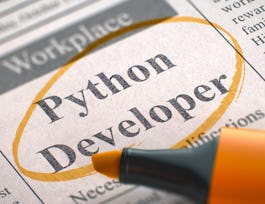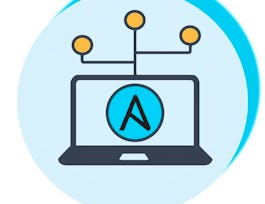This course offers an in-depth exploration of advanced framework development and integration for automation testing professionals. Starting with the Pytest framework, you'll learn its advantages, command-line operations, and grouping mechanisms, along with essential features like fixtures and the conftest file for data-driven testing and HTML report generation.



Advanced Framework Development and Integration
This course is part of Selenium Python Automation Testing and Frameworks Specialization

Instructor: Packt - Course Instructors
Sponsored by InternMart, Inc
Recommended experience
What you'll learn
Implement Pytest for efficient unit testing
Utilize logging for enhanced test reporting
Develop a scalable Selenium framework
Manage repositories and resolve conflicts with Git
Details to know

Add to your LinkedIn profile
3 assignments
September 2024
See how employees at top companies are mastering in-demand skills

Build your subject-matter expertise
- Learn new concepts from industry experts
- Gain a foundational understanding of a subject or tool
- Develop job-relevant skills with hands-on projects
- Earn a shareable career certificate


Earn a career certificate
Add this credential to your LinkedIn profile, resume, or CV
Share it on social media and in your performance review

There are 7 modules in this course
In this module, we will explore the fundamentals and advanced features of the pytest framework. We will start with understanding the advantages of pytest, and move on to running tests from the terminal, selecting specific tests to run, and grouping tests using pytest marks. Additionally, we will cover the importance of fixtures and the conftest file, delve into data-driven testing, and learn how to generate comprehensive HTML reports for test cases.
What's included
9 videos2 readings
In this module, we will focus on the importance of logging within Python tests and how to integrate these logs into HTML reports. We will begin with an introduction to logging in Python tests and the crucial role of file handlers. Then, we will move on to building reusable utilities for logging and demonstrate how to incorporate these logs into pytest-generated HTML reports for better test management and analysis.
What's included
4 videos
In this module, we will guide you through the process of developing an end-to-end Selenium Python framework from scratch. Starting with an overview of Selenium updates and best practices for writing tests, we will delve into generalizing browser invocation code, creating setup fixtures, and passing command-line options for browser selection. We will also cover the implementation and optimization of page objects, creating custom utilities, and integrating logging and data-driven testing mechanisms to enhance the robustness and maintainability of your test framework.
What's included
15 videos1 assignment
In this module, we will explore how to integrate your Selenium Python framework with Jenkins, a popular CI/CD tool. We will start with an introduction to Jenkins and its functionalities. Then, we will demonstrate the integration of your test framework into Jenkins, setting up parameterized job variables for browser selection, and creating JUnit results using pytest commands to streamline your continuous integration and delivery processes.
What's included
4 videos
In this module, we will cover the essentials of incorporating Excel data-driven testing into your Selenium Python framework. We will begin with an introduction to the concept and benefits of Excel data-driven testing. Following that, we will demonstrate how to read and write data from Excel files, build utilities to retrieve and load data, and integrate these utilities into your Selenium Python framework for efficient data management and testing.
What's included
3 videos
In this module, we will wrap up the course by summarizing the key concepts and skills you have learned. We will provide valuable tips and best practices to help you apply your newfound knowledge in a new job, focusing on continuous improvement and effective test automation strategies.
What's included
1 video
In this module, we will delve into the fundamentals of Git, a critical version control system for managing code. We will start with an introduction to Git and its importance, followed by creating Git configurations and repositories. We will cover key concepts such as staging and committing changes, adding remote repositories, and performing end-to-end working examples on Git commands. Additionally, we will explore the importance of branching in Git and provide practical guidance on resolving merge conflicts.
What's included
9 videos1 reading2 assignments
Instructor

Offered by
Why people choose Coursera for their career




Recommended if you're interested in Computer Science

Rice University

Arizona State University

Open new doors with Coursera Plus
Unlimited access to 10,000+ world-class courses, hands-on projects, and job-ready certificate programs - all included in your subscription
Advance your career with an online degree
Earn a degree from world-class universities - 100% online
Join over 3,400 global companies that choose Coursera for Business
Upskill your employees to excel in the digital economy




